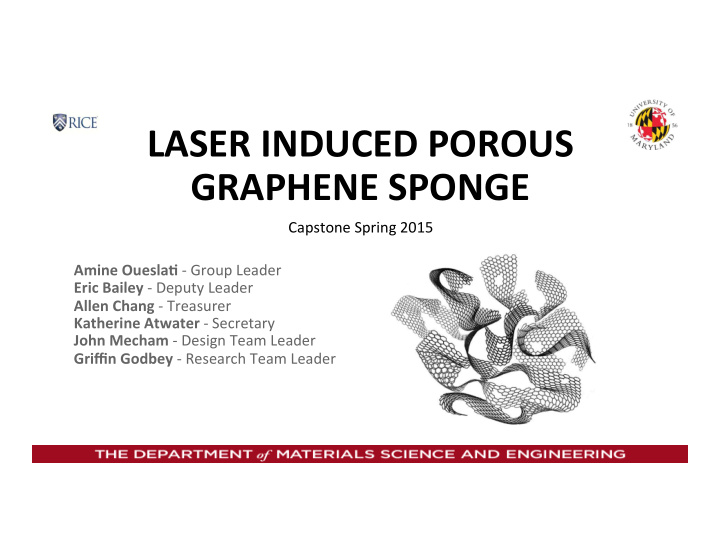



LASER ¡INDUCED ¡POROUS ¡ GRAPHENE ¡SPONGE ¡ Capstone ¡Spring ¡2015 ¡ Amine ¡Ouesla8 ¡-‑ ¡Group ¡Leader ¡ Eric ¡Bailey ¡-‑ ¡Deputy ¡Leader ¡ Allen ¡Chang ¡ -‑ ¡Treasurer ¡ ¡ Katherine ¡Atwater ¡-‑ ¡Secretary ¡ ¡ John ¡Mecham ¡-‑ ¡Design ¡Team ¡Leader ¡ Griffin ¡Godbey ¡-‑ ¡Research ¡Team ¡Leader ¡ ¡ ¡
Motivation and Background
Motivation Oil spills significantly impact: • Wildlife habitats • World economics • Ecosystems • Human Life
Current Technology Polyurethane Spongy graphene CNT water oil Original Coated sponge sponge - 80 grams of oil per gram of - 30 grams of oil per gram of - 70 grams of oil per gram of CNT polymer graphene - excellent selectivity - selectivity if coated - excellent selectivity - Environmentally harmful - Very expensive - Very expensive - Complex processing for - Not scalable manufacturing - Complex, resource selectivity - Very low density intensive processing - High volume needed - Poor mechanical properties - Very low density Zhou, et al., Ind. Eng. Chem. Res ., 2013. 52 (27) Bi, et al. Adv. Funct. Mater., 2012. 22. p. 4421-25 Hashim, et al., Sci. Rep., 2012. 2: 363. p. 1-8
Laser-Induced Graphene § Laser ablation of λ ≈ 10.6 µ m polyimide � § Controllable properties � Laser § Cost effective and scalable � LIG Polyimide
Design Goals
Main Objective: Design a LIG sponge for oil sorption Design Goals: ● Develop atomistic model to understand nanoscale interaction of oil-graphene ● Develop model to understand bulk fluid flow of oil through porous graphene ● Determine a relationship between LIG pore size and oil sorption
Technical Approach: Nanoscale Modelling
Simulation Design The image cannot be displayed. Your computer may not have enough memory to open the image, or the image may have been corrupted. Restart your computer, and then open the file again. If the red x still appears, you may have to delete the image and then insert it again. Pore – 7 Å Pore – 10 Å Pore – 13 Å
Simulation Results
Simulation Results ~600 stretched graphene atoms
Technical Approach: Fluid Flow Modelling
Fluid Flow Modeling Background Goal: Implement Darcy’s Law to understand bulk fluid flow through porous media. " % ∂ X 2 + ∂ 2 ω ∂ 2 ω DaRe ω − F ε 2 ε 2 U ∂ ω ∂ X + V ∂ ω ∂ Y = ε # & ∂ 2 Ψ ∂ X 2 + ∂ 2 Ψ '− ∨ ω $ ( = − ω % ∂ Y 2 Re Da ∂ Y 2 # & $ ' Key Assumptions: • Air omitted from inside porous graphene (space initially empty) • Effects of gravity are omitted Ψ = stream function ; X,Y = coordinates ; ω = vorticity ; Da = Darcy Number ; F = geometric function ; U,V = interstitial velocity components ; ε = porosity ; Re = Reynolds Number ; v = velocity vector; � (all variables are dimensionless) �
Results From Fluid Flow Modelling Low High Low High Low High
Technical Approach: Experimentation
Experimental Procedure Weigh Place Weigh original sample saturated sample partially in sample (LIG+PI) octane Subtract Weigh Exfoliate for mass remainder graphene of LIG of PI from PI
Experimental Findings Graphene wetting Capillary within Linear octane characteristics graphene absorption v. time ● Verified oleophilic ● Increases absorption ● Supports graphene behavior allowing captured sheet spacing is too ● Verified hydrophobic gases to exit the small for alkane bulk behavior system absorption Dry Wet Oil Water Octane
Conclusion
Conclusions • LIG currently has a lower oil absorption than other carbon-based oil sponge technologies • Oil sorption is independent of porosity • The interlayer spacing in the graphene is too small to allow bulk absorption • Octane layers form over graphene surface • Current LIG sponge technology has potential if device is open on both sides
Future Work (a) • Compare oil sorption of LIG with different pore characteristics • Fabricate ideal design using open backside of LIG • Test sorption with crude oil (b) • Investigate mechanical stability during sorption and recovery • Investigate LIG samples with graphene sheet spacing greater than 3.4 Å
Acknowledgments We would like to thank • Dr. C. Preston • Dr. C. Thamire • Dr. J. Klauda • Dr. J. Tour • M. Wistrom • Dr. R. Phaneuf • W. Joost • Dr. D. Liu • S. Lacey • Dr. S. Ehrman • K. Rohrbach • Dr. S. Phillpot • A. Kemp • Dr. P. Kofinas • UMD Deepthought • Dr. Y. Mo • UMD OTC for their guidance, resources, and time.
Supplemental Slides
BP Deepwater Horizon Oil Spill Method Cost Volume Selectivity Recovery Environmentally Safe Corexit 9500 ~$1 billion* ~21.1 m 3 * Yes No No Polyurethane $0.513 billion** ~902,000 m 3 ** No No Yes CNT sponge $91.3 billion*** ~43,500 m 3 *** Yes Yes Yes LIG sponge $2.52 billion*** ~2,640 m 3 *** Yes Yes Yes What this table neglects: • Corexit is dispersant which breaks down oil into smaller pieces to be further broken down by microbes • Spongy graphene can we reused at least 10 times with >99% capacity • LIG can approximately retrieve 80% of oil back. In the case of the BP oil spill over $300 million. * - No specification of oil dispersed ** - Assumption: polyurethane only absorbed oil http://www.bp.com/en/global/corporate/gulf-of-mexico- restoration/deepwater-horizon-accident-and-response/ ***- Assuming each unit of volume is used 10 times offshore.html
BP Deepwater Horizon Oil Spill - Summary Method Cost Volume Selectivity Recovery Environ- mentally Safe Corexit 9500 $$ ✦ ✔ ✖ ✖ Polyurethane $ ✦✦✦✦ ✖ ✖ ✔ CNT $$$$ ✦✦✦ ✔ ✔ ✔ LIG $$$ ✦✦ ✔ ✔ ✔
Recommend
More recommend